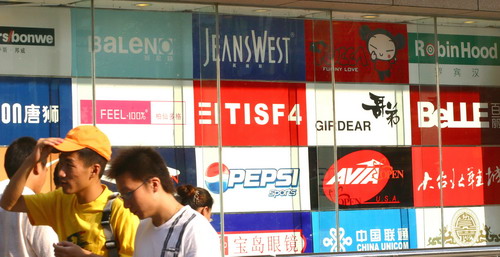Getting the message across
By Meng Fanbin (China Daily) Updated: 2012-04-23 10:17As a result, 4A enterprises quickly set the standard in China's advertising industry.
The year 1979 was seen as "the first year of Chinese advertising", said Dang He, who was also co-founder of Charm Communication.
With global unified working systems, multinationals' branches share the systematic and well-established professional knowledge accumulated by their parent companies, said Shenan Chuang, a senior advertiser, who has worked for Ogilvy & Mather for 27 years.
Ogilvy & Mather Advertising arrived in the mainland in 1991 and is the largest advertising agency in China. It employs more than 2,400 people across 29 offices in 18 markets. It provides its customers with accurate data with the help of professional analysis tools, which draw comparatively correct and effective solutions, said Chuang, stressing that its analysis tools always "keep up with the times".
Corporate culture
"O&M treasures talented people and pays lots of attention to different levels of personnel training," she said.
Besides training, 4A enterprises offer employees plenty of development choices and transfers between different cities and countries are possible, she added. "For example, outstanding persons who work in Beijing have the chance to work in New York."
Proud of O&M's corporate culture, Chuang said a good working environment is one of the most important factors for successful advertising multinationals.
"Unlike Chinese agencies, we are concerned about teamwork rather than individual heroes. Individual ability is important, but we always work as a team."
Chuang, who has been working in Beijing for 10 years, also expressed her view on the localization of multinationals.
"Up to 90 percent of our employees are from China and most senior managers have lived in China for more than 10 years. O&M knows the Chinese market comprehensively and deeply.
"Furthermore, 4A enterprises have never stopped merging and acquiring local advertising agencies," Chuang added. They firstly set up joint ventures with domestic advertising agencies in order to gain access to China's market.
The Provisions on the Administration of Foreign-funded Advertising Enterprises, adopted by the State Administration for Industry and Commerce and the Ministry of Commerce in March 2004, stipulated that from Dec 10, 2005, the Chinese advertising market would be fully open to foreign capital.
In 2005, 4A enterprises started a new round of expansion in China. They set up sole investment subsidiaries to participate in, control, and acquire China's high-quality advertising agencies to build large-scale communication groups.
December 2011 saw O&M's acquisition of Nanjing Yindu Advertising Agency, the largest full-service marketing agency in Jiangsu province. The acquisition bolstered Ogilvy's services and reach in the Yangtze River Delta, a crucial region that encompasses not only Jiangsu province but also Anhui and Zhejiang provinces, the future battleground for global brands and a hot spot for up-and-coming Chinese brands.
"Yindu Ogilvy will further strengthen O&M's offering in second-tier Chinese cities as global brands target the next wave of competition in these critical markets," O&M said on its website.
Through large-scale procurement, multinational advertising companies got stronger, extended their marketing networks, and integrated into the local market, said Huang.
Foreign advertising companies have also extended their business to upstream and downstream industries, such as the survey industry, sales promotion, consulting business and public relations, said Chuang.
Rise of domestic firms
Only one 4A enterprise was included in the CCTV 2010 Top 10 Best Advertising Agencies, which was announced on March 9, 2011, and there were only three among the top 20.
|
 People walking past an advertising board of logos in Nanjing, Jiangsu province. Despite the de facto control of the market by foreign firms, local advertising companies have an edge in understanding local culture. [Photo/China Daily] |
Professor Huang said that "multinationals actually in a way promote the development of China's advertising industry by shortening its growth process. Local agencies learn a lot from their opponents, for example, in the aspects of company management and creativity".
"Local companies, which are familiar with Chinese social circumstances, consumption characteristics and the local media, integrate closely with Chinese culture and satisfy the needs of local customers," said Charm Communications Chairman and Chief Executive Dang He.
By April 2011, 14 Chinese local advertising agencies had been listed.
In 2010, four corporations went public in succession - Spearhead, Bluefocus, Charm Communications and Guangdong Advertising.
Other Chinese advertising companies such as D&S Communication Group, Who's Who Advertising, Linksus and Shunya Communication Group are planning IPOs.
"Focus Media's listing on the Nasdaq set an example for other domestic advertising agencies to finance on the stock market. A growing number of Chinese advertising companies will be listed in the near future," said Zhang Xiang, vice-dean at the School of Communication and Art at Beijing Technology and Business University.
The rapid capital reconstruction of domestic agencies promotes their own development. For instance, Guangdong Advertising has enlarged its operating scale through assets recombination.
- China outbound M&A beats 2015 record with 6 months to spare
- Fosun-owned Club Med to open Hokkaido resort in 2017
- Dutch giant bullish on dairy in China
- Wal-Mart to sell its China e-commerce operation to JD.com
- Parkson to shift its focus to lower-tier cities
- 'Big Bang' to Brexit: The City of London fears end of golden age
- CIMC ENRIC to use Internet Plus solutions to sustain growth
- More western filmmakers tend to seek Chinese partners


















